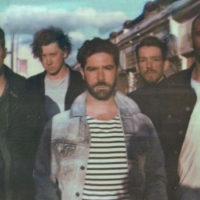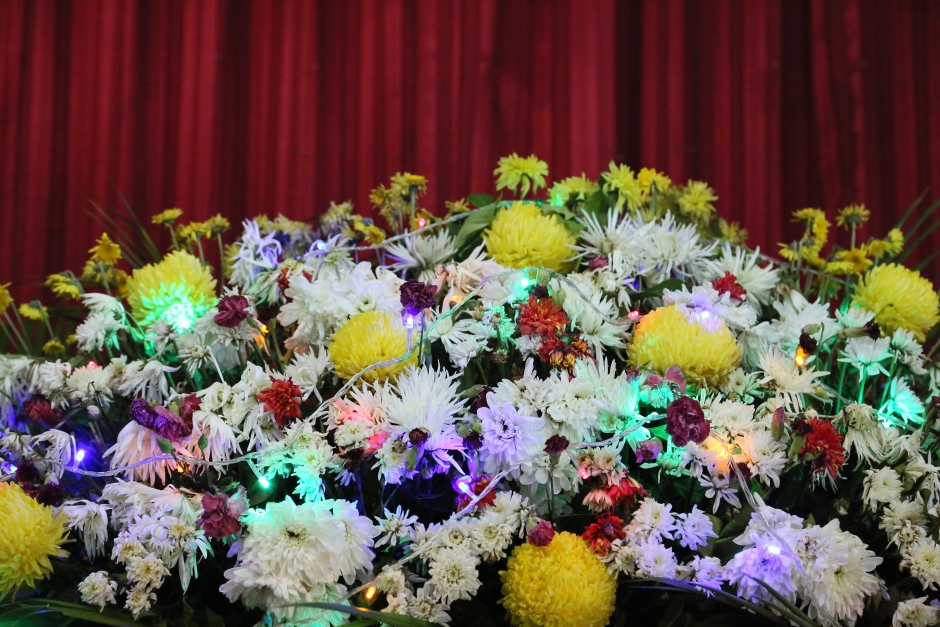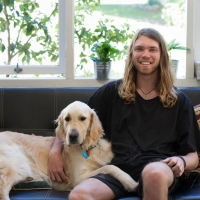 At The Gates Of World Domination With FoalsFoals on making the perfect album, and the entire concept behind What Went Down.
At The Gates Of World Domination With FoalsFoals on making the perfect album, and the entire concept behind What Went Down.

Gold Leaf and Floral Wreaths: A Look at Nathan Beard's Cross-Cultural Impetus
Talking to the acclaimed artist ahead of tonight's Fremantle Arts Centre Print Award.
The Fremantle Arts Centre Print Award, now in its 40th year, is one of the finest in the country. Accompanied by a diverse exhibition, the event showcases prints and artist books with $22,000 in prize money, making it the most prestigious of its kind in Australia. The 2015 event, Multiple Choices: 40 Years 40 Winners, presents 21 winning works from artists including Peter Burgess, Neil Emmerson, Joel Gailer, Peggy Griffiths, Jodi Heffernan, Sally Morgan and Alick Tipoti, with a strong focus on tracking the evolution of print as an art form throughout Australian history and legacy. With over 60 artists represented, this year's exhibition features the likes of Alison Alder, Teelah George, Steve Wilson, Nick Mahoney, The Usual Collective and Nathan Beard. The gallery walls will also be projection-mapped by every winning work since the inaugural award – itself a video installation work by WA filmmaker Steven Aaron Hughes. Supported by Little Creatures Brewing, the event commences tonight at 6.30pm in the main gallery.
In preparation, we were lucky enough to chat with inter-disciplinary artist Nathan Beard, whose work Anemone was selected as a contender for 2015. Beard's practice is a stunning introspection, examining existential themes through personal connections. His own diasporic Thai-Australian background serves as the creative impetus behind an ongoing visual conversation, spread across both countries through numerous residencies, mentorships, exhibitions and trips abroad. Beard's process has been a public evolution, deriving his art from profound and personal discoveries of an estranged cultural and familial heritage. These journeys have been beautifully crafted, packaged and shared to us through gallery spaces and online documentation, presenting histories that evoke, inspire and resonate with audiences. Anemone is hauntingly serene, reflective and truly multi-faceted, and we're pleased to be able to bring you these words from the artist himself ahead of the awards.

Hi Nathan! First of all, congratulations on being selected for the FAC Print Award! How are you feeling about it, and what have you been up to lately?
Thank you. It’s a great honour to be selected alongside a pool of really interesting artists I admire and I’m happy to have a platform in Perth where I can display a work from a recent series I developed in Thailand. I’m currently on holiday in London after completing a residency with a group of other West Australian artists in the Royal Pavilion in Brighton, for a project curated by Andrew Nicholls. While I’m here I’m doing research in museums to gather inspiration for new work.
What was the inspiration behind your piece, Anemone?
The piece documents a bouquet that was displayed on the coffin of my uncle during his funeral in Nakhon Nayok, Thailand in January 2014. Traditional Thai funeral ceremonies last for around a week and the floral wreaths donated by the friends and family of the deceased (here adorned with fairy lights on top of a gold embellished coffin) would wither and decay during the course of the ceremony. With this work I wanted to reflect upon the vibrant aesthetic of these funeral customs that contrast wildly with the sombre tone of Western funerals, lending permanence to this ephemeral tribute in the form of a monument that plays with the memento mori tradition. The title of the work comes from the anemone flower, which according to different cultures carries connotations of death and illness. The wind which blows the blossoms of the anemone open are also responsible for blowing its petals away, meaning that the force which gives it life is ultimately responsible for it perishing.
The presentation is quite unique, what can you tell us about it?
Two photographs are printed on diaphanous sheets of synthetic silk, suspended on a wooden frame, so that they gently undulate in response to the movement around them, whether caused by the movement of people around the prints or the flow of air conditioning vents near the work. One image is presented in sharp focus and the other abstracts the flowers into a gauzy colour field, so that when the viewer encounters the work the layers of this still life shift subtly. The presentation of the images on a frame gives them an ethereal physical presence in the space, which supports the idea of the work being a monument to this intimate, slippery transaction between memory, tradition and legacy.


A main theme of your work so far has been the idea of duality, and occupying the space between dichotomies like East versus West. When did you first discover art as a means of grappling with that question?
These themes developed in my work as a response to a body of work I made in 2010 for an Honours project, which used my Thai mother as a subject and collaborator on a number of different pieces. On a personal level I wanted to sincerely investigate this idea of Thainess, and unpack what it meant to grow up with a legacy of this specific culture in an Australian context. Art became an interesting way to creatively engage with this line of questioning.
As someone who grew up in a Western country, what were your perceptions of your own Thai background before you first spent time there, and how have they changed since?
My understanding of Thai culture came to me through my mother and my aunt, and specifically the way they preserved traditions related to food and religion on a domestic level. I grew up with Thai food and Buddhist shrines around the home, and spent weekends going to Thai grocery stores and temples, being exposed to their ties to the Thai community in Perth. Since visiting their province in Thailand, I can see that they definitely managed to preserve aspects of this culture, but that I was engaging with it at a level that was hybrid. I’ve come to understand how foreign their traditions and culture are to me because of an Australian context, and since visiting my Thai family the significant role that the language barrier plays has really become pronounced.
A large portion of your autoethnography began with explorations of your mother’s connection to her home, what was your own relationship with that space like? How was it fostered throughout your visits?
Her home in Thailand for me is steeped in nostalgia, because I was very young when I first visited it. I became empathetic to the fact that the shrines in her home in Perth, and the garden here, were attempts to cultivate a space that reminded her of Thailand. On a practical level it meant that she could practice her religion and eat the food she liked easily, but it also became apparent that this domestic space in Australia was modelled in some degree after the one in Nakhon Nayok. I’m continuing to explore this idea of how memory and legacy are collectively entwined with this respect for nostalgia as a result of positioning myself between these two notions of home.
Going back to an earlier body of work, something that really stood out to me from Obitus was your use of antiquated family photographs found in your mother's home. What was this process of unearthing your heritage like on a personal level?
The process of opening the house up felt like opening up a tomb dedicated to her family history, in the sense that it was abandoned for so long and that personal items were left untouched and exposed to the elements. It was haunting to encounter a family history that I was essentially estranged from, and it provoked a desire to compile as much information about these artefacts as I could through my mother’s perspective. I initially felt sort of removed from the contents of the home, but at that same time my emotional response was of feeling overwhelmed at the sheer weight of unknown history that had so suddenly made itself feel present.
The way the photos were presented in the exhibition evoked a strong sense of nostalgia, what kind of response did it trigger from the public?
I think presenting this intimate archive to the public connected with some viewers in an emotional way. They could see decades of personal history collapsed across a few images and I think it provokes some audiences to reflect upon their own family legacies and histories. I wanted the work to speak intimately about broad existential themes like death and the passage of time.
How has this ongoing conversation with both Thai and Western audiences through a creative medium affected the way you understand and perceive your own diasporic identity?
Having access to Thai and Western audiences allows me to consider the nuances that influence how the work may be read differently in different contexts. It’s made me aware of how my heritage affords me a double consciousness, and I feel a weight of responsibility towards how my work shifts between cultures.
Spoken language, in addition to visual, played a large role in your earlier work; as someone who grew up between cultures in a sense, do you see it as a barrier or a path to mutual communication?
I’m not bilingual, my Thai is quite poor and this has definitely created a barrier at times when I’ve been researching work in Thailand. I’ve relied on the generosity of Thai friends and family to translate for me and I don’t think a lot of my work would have been achievable without this language skill. The spoken word has been important to my work in the form of narration and the transmission of knowledge through an oral tradition though. This form of communication has been very important for my practice.
The original concept for Obitus was a broader exploration of Thai spirituality and your mother’s abandoned home, later changing to centre on her relationship with the land as your collaborator and subject. How did this shift to the explicitly personal affect the way you communicated explorations of the culture; were there ever times that you felt something was too personal or sanct to exhibit?
I saw that the focus of the work became less about the specifics of her Thai culture than it did about the generational exchange between mother and child. This connected the works within the exhibition to broader, more universal themes that I think resonated with audiences. Her cultural and geographical context were essential textures to the work, and they provided nuances that connected different pieces within the body of work. I used the intimacy of our relationship in order to create a detailed and profound portrait of a subject, and this made it hard at times because it was an emotional process for me as well. My biggest concern wasn’t whether something would be too personal to exhibit, but whether it would be of interest to the audience.
Your past work has included material elements like gold leaf that are particularly reminiscent of Southeast Asian ritual and tradition – did their use come naturally to your work or was it a decision you factored in consciously?
It was an essential texture to incorporate into my work from an early stage because it was an earnest way to explore the aesthetic influence and legacy of my mother’s culture. It factored into my work naturally because it was folded into this early collaborative work with her that was specifically modelled after her Buddhist shrines. They excite me visually in a completely unironic way.
A project we’re fascinated by is The Greater Asia Co-Prosperity Sphere, how did the idea behind it come about?
The work was a collaboration between myself and two other West Australian born artists, Abdul Abdullah and Casey Ayres. The work was a fictional embassy space for a Pan-Asian empire led by three Eurasian ambassadors, and was presented as a detailed installation with a performance aspect at the 2012 Next Wave Festival in Melbourne. The project was modelled after a failed Japanese imperialist concept for an empire of Asian nations called The Greater East-Asia Co-Prosperity Sphere; which we resurrected to be inclusive of Australia and the Pacific. We wanted to create a space that was directly informed by our perspectives of growing up in an Australian context with the influence of an Asian parent, and responsive to contemporary discourses of globalisation and multiculturalism. It was a playful, tongue-in-cheek exploration of several influences that bridged the personal with the political, with an aesthetic inspired by kitsch Orientalism.
You've had a series of truly engaging works over the past few years, what do you have planned for the rest of 2015?
I have a body of work presented in the 2015 City of Joondalup's Invitational Art Award, which is responding to a lot of found photographs and old Super 8 video footage of my mum’s province. The research for that body of work has been really engaging, so I’m keen to to keep working on these ideas and the wealth of material from the Brighton residency, and get a productive studio environment happening as soon as I’m back in Perth.
 At The Gates Of World Domination With FoalsFoals on making the perfect album, and the entire concept behind What Went Down.
At The Gates Of World Domination With FoalsFoals on making the perfect album, and the entire concept behind What Went Down.
 James Giddy's Natural WorldWe sat down with Perth-based artist James Giddy ahead of his solo exhibition, Dreams Aside.
James Giddy's Natural WorldWe sat down with Perth-based artist James Giddy ahead of his solo exhibition, Dreams Aside.







